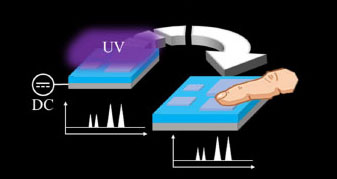| Oct 26, 2023 | |
New method enables reliable low-power triboelectric sensors for wearables |
|
| (Nanowerk Spotlight) Triboelectric sensors operate through contact electrification—the electrical charge transfer that occurs when two materials are brought into contact and then separated. This phenomenon allows triboelectric sensors to convert mechanical stimuli like touch or pressure into electrical signals. In this way, they can detect tactile inputs similarly to our skin. | |
| However, triboelectric sensors currently face reliability limitations that have restricted their real-world use. Specifically, the output signals from triboelectric generators vary significantly over time, even when subjected to identical mechanical inputs. This reduces the accuracy and consistency of the sensor data. In addition, the electrical signals require many initial stimulation cycles at the start to build up and saturate the surface charge. Only after this initial saturation do the signals become quantitative. This precludes using triboelectric sensors for one-off or intermittent measurements. | |
| Together, these issues of variable output and required pre-conditioning have limited the applications of triboelectric sensors, despite their potential as artificial electronic skins and touch interfaces. | |
| A team from South Korea aimed to tackle these issues. They developed a new method to make triboelectric sensors more reliable. These sensors can now produce the same electrical signals when touched, no matter when or how often they are touched. The team used special UV light (254 nm) to create areas on the sensor that are sensitive to touch. They also used direct current (DC) to keep the sensor's electrical charge stable for up to 30 minutes. This makes the sensor more useful for a wide range of applications, from wearables to robotics. | |
| The researchers reported their findings, which let triboelectric sensors provide consistent touch or pressure data, in Nano Energy ("Design to secure temporal invariance of triboelectric sensing signals"). | |
| "We introduced a principle and condition for assuring identical sensing signals for the same stimuli at any time in triboelectric sensors," Jin Kon Kim, a professor at Pohang University of Science and Technology and Director of the National Creativity Research Initiative Program for Smart Block Copolymers in Korea, who led the study, tells Nanowerk. | |
 |
|
| Graphical abstract of the work: Frequency-independent triboelectric tactile sensor. (Image: Provded by the researchers) | |
| The researchers first examined how to confine triboelectric charges to controlled surface regions. They used a mask to pattern ultraviolet light onto a polymer film surface. This selectively transformed areas into 'triboelectric active' regions surrounded by insulating boundaries. | |
| Tests showed the insulating gaps created substantial potential barriers around 60 micrometers wide. This meant generated surface charges stayed confined within the UV-exposed patterns. The team also discovered the output voltage and current scaled linearly with the patterned area fraction. This quantitative relationship enabled precise tuning of sensor signals by adjusting the UV light patterns. | |
| Next, they investigated how to extend the time triboelectric sensors stay saturated after initial stimulations. Applying high voltage DC charging was found to fill deep charge traps in the UV-exposed regions. This significantly increased the charge retention time from a few minutes to over half an hour. | |
| Kim further elaborates that their approach fulfilled three critical requirements: "High tactile sensitivity with a low error range, fabrication of tribo-active patterns on a flat flexible substrate, and identical signal output at a given stimulus at any time regardless of the stimulation frequency." | |
| The researchers constructed a sensor with five UV-patterned squares of increasing size. Despite randomly touching these regions at arbitrary intervals, the sensor generated distinct, unchanging outputs for each pattern. This allowed identifying the touch locations and sequences. | |
| The new techniques open avenues for practical triboelectric devices. Precision patterning grants accurate control over sensor signals. Extended charge retention enables consistent touch detection, even at low frequencies. Together, these could enable applications from robotics to healthcare monitoring. | |
| However, there is still room for improvement, particularly in the device's performance under different environmental conditions. Kim noted that the device's performance starts to degrade at high levels of humidity. "The performance of our TES was stable up to 60% of relative humidity but degraded after 80%," he said. This highlights the need for a protective cover layer in future versions to maintain device stability. | |
| Looking forward, the research will aim at further simplifying the sensor systems. "Our future study focuses on developing a multifunctional sensor system with a simple structure, such as integrating our TES with various sensors like pressure, temperature, and strain," added Kim. | |
| While further work remains, the research demonstrates key steps towards real-world triboelectric sensors. The simple methods enable fabricating sensors on flat, flexible substrates. Matching signal invariance with sufficient retention time also unlocks quantitative, frequency-independent operation. This builds confidence that triboelectric devices may one day fulfill their promise as durable artificial skins and flexible sensors. | |
 By
Michael
Berger
– Michael is author of three books by the Royal Society of Chemistry:
Nano-Society: Pushing the Boundaries of Technology,
Nanotechnology: The Future is Tiny, and
Nanoengineering: The Skills and Tools Making Technology Invisible
Copyright ©
Nanowerk LLC
By
Michael
Berger
– Michael is author of three books by the Royal Society of Chemistry:
Nano-Society: Pushing the Boundaries of Technology,
Nanotechnology: The Future is Tiny, and
Nanoengineering: The Skills and Tools Making Technology Invisible
Copyright ©
Nanowerk LLC
|
|
|
Become a Spotlight guest author! Join our large and growing group of guest contributors. Have you just published a scientific paper or have other exciting developments to share with the nanotechnology community? Here is how to publish on nanowerk.com. |
|
